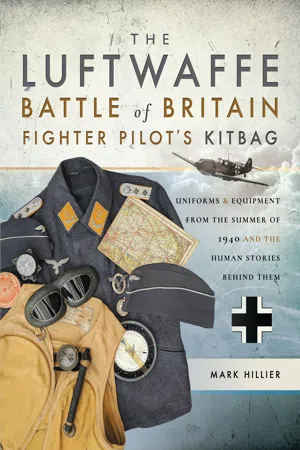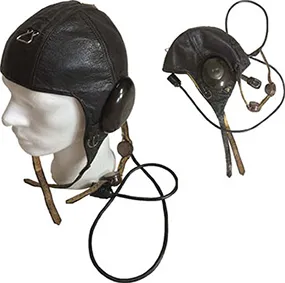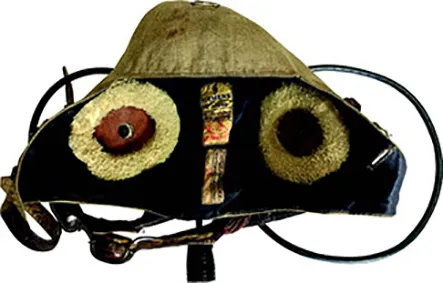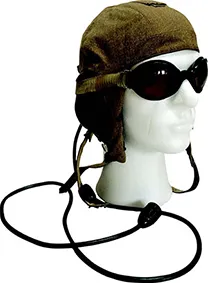![]()
Section 1
FLYING HELMETS
The Luftwaffe had available to them three types of flying helmet, depending on the climate or temperature, as compared to the RAF with only the B Type leather flying helmet. The Luftwaffe authorities and the manufacturers had realised that the purpose of the flying helmet had changed somewhat since the early days of open-cockpit flying when the helmet was offering protection against the elements. The design criteria were now focused on the helmet being a comfortable fit and to enable free movement as well as ensuring that the acoustic quality of the earphones and microphone were not compromised. Regarding the oxygen supply, the priority was to ensure that it was free flowing when needed at altitude and that it did not pull off of the face during high G manoeuvres. So its securing to the helmet was of key importance.
All of these helmets featured utilised the throat-type microphone whereas the RAF had chosen a microphone within the oxygen mask. The helmets were categorised into three basic types: those made of linen for use in a warm climate which carried the designation ‘S’for ‘Sommer’, those made of leather and lined with lamb’s wool for colder climates which carried the designation ‘W’ for winter and lastly a lightweight helmet constructed with net panels for use in very hot climates or weather which had the designation ‘N’ for ‘Netzkopfhaube’. In this book I have concentrated on the flying helmets fitted for radio communication that were mainly in use during the Battle of Britain.
The Luftwaffe had also spent a considerable amount of time on research into the development of oxygen masks. There were two main models issued pre Battle of Britain, both fitted well and had a three-strap system which ensured a good fit and chamois leather interiors to help a tight fit against the face and provide some comfort. The early masks from the 1930 period unfortunately proved prone to freezing at higher altitudes due to the moisture being exhaled. The Luftwaffe went on to produce a fighter mask model with two straps and a heated range of masks to prevent freezing as well as a non-heated, non-freezing mask in 1939 which was particularly popular.
Regards goggles, it was appreciated that pilots still needed protection to prevent dust in the eyes, flying fragments and insects but they had issues that needed to be overcome to ensure the pilot could maintain optimum vision for tactical advantage. All goggles could be prone to fogging up and optical deficiencies, amongst other issues. Early on the Luftwaffe realised that the interaction and fitting between the flying helmet and the goggles was also important. As a result the LKp S and W 101 series of helmets incorporated a moulded notch for retaining the strap of the flying goggles, ensuring a better fit. Interestingly some models also had tinted lenses to aid with looking for enemy aircraft in the sun, essential for a fighter pilot who had to have a swivel neck and eyes on stalks to
A typical Battle of Britain flying helmet setup of an early LKp S 100 with aluminium domed ear pieces, three-strap 10-67 oxygen mask and Model 306 Fliegerschutzbrile goggles. (Mick Prodger Collection)
gain the upper hand in combat. As a comparison the RAF Mk IIIa goggles did not have this option and only later models of the RAF goggles carried flip-down shades.
FLYING HELMET MODELS LKp W100 AND LKp S100
Essentially these two helmets were the mainstay for aircrews in the Battle of Britain, both having the provision for earphones and throat microphones. The summer-weight flying helmet is constructed of a tan-coloured linen material and normally is found with a slate-grey synthetic satin-type lining. The winter weight is constructed to the same essential pattern but from dark brown goat’s leather with
is shown the LKP S100 (summer weight) version of the classic flying helmet showings its domed aluminium ear phone cups distinctive to this version. Note the throat microphone preferred by the Luftwaffe. This also has a three strap 10-67 oxygen mask very typical of the period. (Mick Prodger Collection)
RIGHT is the same helmet worn with the Model 306 goggles. The throat microphone was not without its issues and if too tight could cause the wearer some discomfort if too tight and if too loose, poor communication! (Mick Prodger Collection)
A clearer image of the flying helmet on its own showing the top triangular connection for the middle strap of the oxygen mask and the throat microphone arrangement. These flying helmets are the iconic versions which you will see in period Luftwaffe photos. (Simon Lannoy Collection; www.themilitariadealers.com)
Here is the winter version of the LKp 100 flying helmet. Of leather construction this time but essentially the same pattern with lamb’s-wool lining for comfort at altitude or low temperatures. Exactly the same connection points for the three-point oxygen mask and the same throat microphone. Again photos of this variant exist from the Battle of Britain period. (Paul Woodbyrne Collection)
The early round throat microphone on the LKp W100 flying helmet with its connector lead and plug for the radio. Although this style of microphone was the mainstay of the Luftwaffe flying helmets, it was not ideal and could be uncomfortable if too tight. (Paul Woodbyrne Collection)
The LKp W100 flying helmet again, worn with the early second pattern Model FL.30550 Splitterschutzbrille flight goggles with the solid bridge, illustrating the fact that the goggles do not sit on the earpiece very well and ride up, especially when pulling G in combat! (Paul Woodbyrne Collection)
Hauptmann Helmut Wick of 1/Jagdgeschwader 2 in the cockpit of his Bf 109E-4. Note he is wearing an LKp W100 helmet and the Knight’s Cross which he was awarded on 27 August 1940. He would be awarded the Oakleaves to it on 6 October 1940. Rather than issue leather flying gloves he is wearing his officer’s dress gloves. He was killed in action on 28 November 1940. (Chris Goss)
A boxed Knight’s Cross of the Iron Cross, the same as that awarded to Helmut Wick on 27 August 1940. This example was manufactured by Juncker. (Ken Aitken Collection)
The front cover of Helmut Wick: Das Leben eines Fliegerhelden which, published in two different versions by the Luftwaffe magazine Der Adler, the first being in 1943, carries an excellent portrait of Wick. He can be seen wearing his Schirmmutze (or uniform peaked cap), this one showing the typical ‘saddle form’ of the period, and a Tuchrock (or service tunic with the silver officer’s piping to the collar). Wick is also wearing the Knight’s Cross with Oak Leaves around his neck. On his tunic button is the ribbon of the Iron Cross Second Class, which he gained in 1939. On his chest is the ‘Sudenetenland’ medal ribbon. The Flying Badge and Iron Cross First Class would be worn on the breast pocket, but these cannot be seen in this portrait. The collar badges show the rank of Major with the gold yellow Waffenfarbe of flying personnel. (Historic Military Press)
Internal view of the LKp S100. (Paul Woodbyrne Collection)
a white lamb’s wool lining. Both helmets have brown domed aluminium protective cups over the earphones which are iconic to the period concerned.
Internally both had the earphone surrounds covered in lamb’s wool to help prevent undue pressure on the wearer’s ears. Too much pressure on the head on long flights would cause a headache. Both had two snap fasteners on leather straps externally at the rear which held the goggle elastic in place. They were secured to the head by the use of dual chinstraps and these were buckled to the helmet on either side.
The oxygen mask was connected to the helmet by a single hook on each side of the face, just under the protective cover to the ear and then a single non-elasticated strap and slide buckle up and across the nose to the forehead where the mask was held in place by a triangular hook which was connected to a short length of adjustable strap. This ensured a good fit of the mask over the nose and mouth.
FLYING HELMET MODELS LKp S AND LKp W101..
These models were essentially identical in materials to the 100 series, with the winter variant being lined with lamb’s wool, the principal difference being the construction of the earphone housings. On the 101 series the earphones were of moulded dark-brown leather. The earphone cover also differs in that there is a notch in the side of it for retaining the goggles in position as shown in the photographs. These were available from 1938 and had improved earphones for radio communication and were a vast improvement on the 100 series. Again, all of the flying helmets are well marked internally with maker, model and often date.
A summer LKp 101 helmet showing the sculpted earpiece allowing the better fit of the goggles. Note the helmet retained the three fixing points for the oxygen mask. This and its winter variant had much better electronics for improved communications and were available after 1938. (Paul Woodbyrne Collection)
T...









